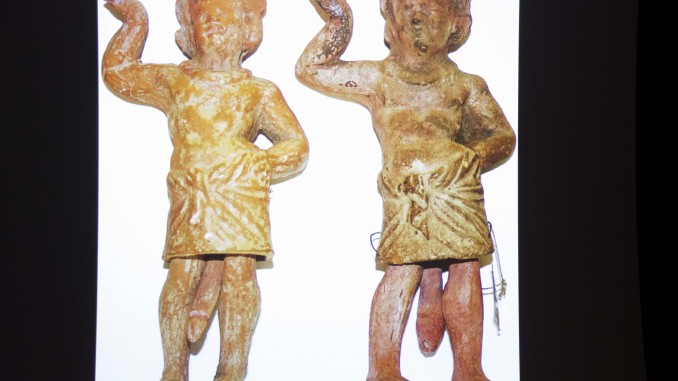
Art historian and archaeologist Maya Muratov came to campus with a message: in terms of our questionable tastes in popular entertainment, people have not changed at all, even since antiquity.
Muratov, a professor at Adelphi University, spoke on Thursday, March 3 to a crowd of more than 50 people about her studies of puppet theatre in the ancient world. Professors from the Art Department introduced her and thanked the history, theatre and art departments at New Paltz, who with the help of other offices funded Muratov’s lecture.
Channeling an evening at the theatre, Muratov broke her presentation down into five acts. She put her topic of choice in context: compared to other forms of entertainment in ancient Greece, Rome and Egypt, puppet theatre was considerably more “low-brow.” It was popular culture for the uneducated masses and people on the lower end of the social strata.
As such, the subject matter often opposed the formality and decorum of elite civilization, revolving instead around immoral and indecent comedy. Muratov’s discipline is something of an anomaly: according to the art historian, puppet theatre is rarely addressed in scholarly works about ancient culture and entertainment.
“No contemporary books on Greek or Roman theatre even mention puppets,” she said.
Ancient forms of popular culture came in many shapes and sizes, including entertainers like musicians, magicians, poets, dancers or fire eaters. According to Muratov, these entertainers could be found in unexpected places, like schools, temples or even funerals. Many were simply poor, uneducated people trying to make money on street corners. She linked these entertainers to more contemporary circus performers or street artists, many of whom have physical differences that made them unique. Performers even in antiquity would capitalize off of their unique appearances, using their bodies as a “form of currency” in their performances, Muratov said.
One of the few allusions to puppets or marionettes in ancient texts came from the writing of a Roman noble, Muratov said. The nobleman described elaborate dinner parties filled with entertainers, some of whom were said to have brought metal figurines resembling puppets to the party.
However, Muratov doesn’t believe that these figurines fall under the art world’s definition of puppets. Most ancient art scholars would tend to agree with her too, and as such, there aren’t any universally recognized examples of ancient puppetry to date.
For potential evidence of puppets in antiquity, Muratov pointed instead to ancient clay figures from a private, unpublished art collection in New York City. The art historian said she was granted access to this collection under strict conditions. She asked the audience to refrain from photographing the ancient clay puppets, garnering a few curious looks from attendees.
The privately-owned clay puppets were, for the most part, fully intact. The way their bodies were constructed and held together led Muratov and other ancient art scholars to believe that the New York City puppets were attached to small puppet theaters and operated by hand. Funnily enough, the puppets’ sex was indicated by their exceptionally large phalluses — something Muratov noted was a common feature of comical art and theatre in antiquity. It would seem that even ancient Greeks and Romans could get a good laugh out of a crude joke.
